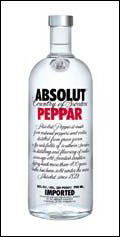Vodka
 From Conservapedia
From Conservapedia 
Vodka is a distilled spirit with a high alcohol content that can be produced from a number of different vegetables and grains and possesses different characteristics depending on the creator. Most vodka produced these days is made from a grain, though some is still made from potatoes. The exact history of vodka is unknown, though it most likely originated somewhere in the region of Poland or Russia between the 13th and 14th centuries. The word is thought to derive from Russian, meaning roughly little water.
The majority of vodkas produced today for consumption in the United States and Western Europe are made from either wheat or rye and are heavily filtered. By law, in these regions, vodka cannot have a distinctive color, smell, or flavor. It is, in many ways, a pure spirit, which is one reason it is so popular in mixed drinks and as a base alcohol for flavored spirits.
Traditionally, vodka may be made from virtually anything; vodkas can be found made from grapes, soy, beets, bread, potatoes, and corn, in addition to the more common wheat and rye varieties. Some vodkas are even made from leftover material in the oil refining process. In many Eastern European countries, vodka is not heavily filtered as it is in the west, and so the flavors, smells, and colors from the source materials still shine through.
Vodka has also traditionally been flavored in many countries, either for pure enjoyment or for health reasons. Pepper vodka, as that produced by Absolut is perhaps the most widely known flavoring, favored in Russia, but fruit vodkas and vodkas flavored with spices such as cinnamon or vanilla are also not uncommon. Many nations also have a tradition of infusing vodka with healing herbs, such as chamomile, belladonna, or comfrey.
The alcohol content of vodka varies widely, as it may be distilled to any level of alcohol. In most cases, vodka which contains 40% alcohol (80 Proof) is the most common, for a number of reasons. Historically, Alexander II of Russia set certain standards for vodka production in his country, one of which was a required alcohol level of 40%. This level continues to be the most popular, in part because the United States and many European countries set their tax levels of spirits based on the alcohol content, and 40% spirits have a reasonable amount of taxation. Vodka that contains 50% alcohol (100 Proof) is also fairly common in the United States and Europe, as is watered-down vodka of 20% (40 Proof).
While many vodkas from Slavic countries are very harsh in taste, many vodkas made in Scandinavian countries tend to be much milder and have more of a sweet taste.
Categories: [Alcoholic Beverages]
↧ Download as ZWI file | Last modified: 02/19/2023 07:17:11 | 62 views
☰ Source: https://www.conservapedia.com/Vodka | License: CC BY-SA 3.0
 ZWI signed:
ZWI signed: KSF
KSF